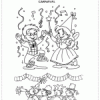
O skeletal system It is composed of bones, cartilage, ligaments and tendons.
O skeleton is the protection of internal organs, supports the body and allows movement because working in conjunction with the muscular system.
see more
Biology teacher fired after class on XX and XY chromosomes;…
Cannabidiol found in common plant in Brazil brings new perspective…
We prepared a list of exercises on the skeletal system so you can study and test your knowledge about it.
You can consult the feedback and save this list in PDF at the end of the post!
1) We know that the skeletal system is composed of a large number of interconnected bones that form the skeleton. These bones are formed by bone tissue, a type of connective tissue that is made up of three cell types: osteoblasts, osteoclasts, and osteocytes.
Among the alternatives below, mark the one that correctly indicates the function of the osteocyte.
a) Osteocytes produce the organic matrix.
b) Osteocytes are mature cells that help maintain the bone matrix.
2) (FUVEST) In addition to supporting the body, the bones have the following functions:
a) store calcium and phosphorus; produce red blood cells and white blood cells.
b) store calcium and phosphorus; produce glycogen.
c) store glycogen; produce red blood cells and white blood cells;
d) store vitamins; produce red blood cells and white blood cells.
e) store vitamins; produce plasma proteins.
3) (UDESC) Determine the alternative that correctly indicates the name of the bones that make up the upper limbs (arms and forearms).
a) Ulna, tibia and fibula.
b) Humerus, tibia and fibula.
c) Radius, tibia and ulna.
d) Humerus, radius and ulna.
e) Clavicle, radius and fibula.
4) Bones can be classified, according to their shape, into long, short, laminar, irregular and sesamoid. All of the bones listed below are long except:
the radio.
b) Tibia.
c) Femur
d) Ulna.
e) Scapula.
5) What is the main function of floating ribs?
a) Human locomotion.
b) Protect internal organs such as kidneys, spleen, etc.
c) Send signals to the brain.
d) Protect the brain.
e) Improved posture.
6) The skeleton is traditionally divided into axial and appendicular skeleton. Identify from the alternatives below the only bone that is not part of the axial skeleton.
a) Skull.
b) spine.
c) Ribs.
d) Radio.
e) sternum.
7) How many vertebrae does the human body have?
a) 25 vertebrae.
b) 19 vertebrae.
c) 24 vertebrae.
d) 35 vertebrae.
e) 31 vertebrae.
8) How many bones does a child have at birth?
a) 206 bones.
b) 200 bones.
c) 300 bones.
d) 245 bones.
e) 403 bones.
9) Which cavity is part of the soft palate?
a) Nasal cavity.
b) Muscular cavity.
c) Posterior ear cavity.
d) buccal cavity.
e) Lumbar cavity.
10) Where is the smallest bone in the human body located?
a) In the ear.
b) On the nose.
c) On the head.
d) On the neck.
e) On the leg.
1 — b
2 — the
3 — d
4 — and
5 — b
6 — d
7 — c
8 — c
9 — d
10 — the
Click here to save this list of exercises in PDF!
See too:


